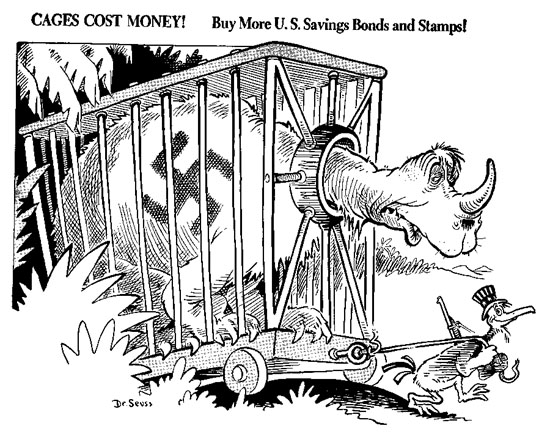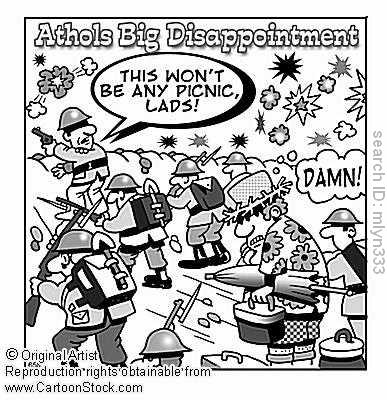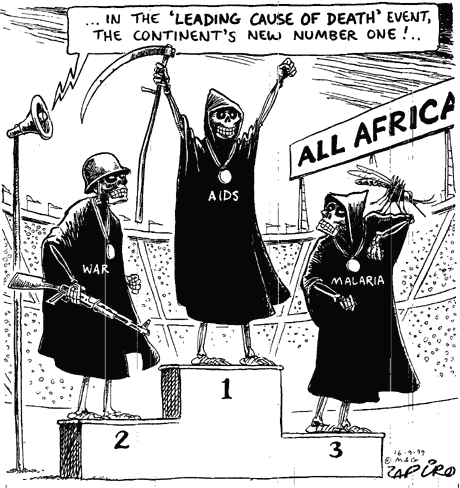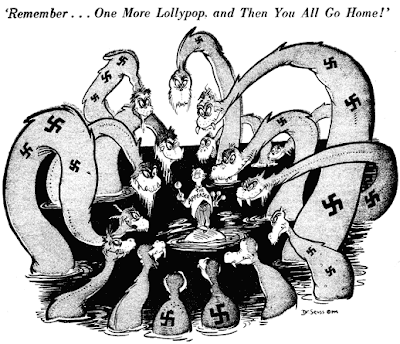
The first real political cartoons were drawn back in the early 1500's in Germany during Martin Luther's campaign against the excesses of the all-powerful Catholic Church. During this time of upheaval, Martin was looking for a way to use the new printing press to get his message out to the masses. Unfortunately, the "masses" were largely illiterate peasants who had previously relied entirely on Catholic Clergy for all access to the written word. Since the message Luther sought to distribute was inherently against the Church, he knew he needed a different way to reach the common people. The political cartoon was born.

Looking less like our modern cartoons and more like detailed illustrations, these early cartoons made use of familiar characters and stories to appeal to the peasants in a way that they could easily understand. One of these early cartoons shows the scene where Jesus throws the peddlers and hawkers out of the temple, a Bible story that all onlookers would easily recognize. Opposite the Bible scene is another which shows the Pope writing out and selling indulgences to the people. The comparison of the Pope to the hawkers is unmistakable. In this way, Martin could expose people of all classes to his radical and complex ideas in a way that was both simple and entertaining.

The first real use of political cartooning by an American was Benjamin Franklin's 1754 cartoon "Join, or Die." Its image of a snake cut into eight pieces, each of which was marked as one of the eight colonies, was a direct call to all of the British colonies to unite in common cause against the French and Indians and their plans to take over land west of the Appalachians. Later, in 1765, Franklin would again use the cartoon to try to persuade the colonies to unite in order to fight the British for independence. In both cases, the image of the snake became a stark and easily recognizable symbol around which the unity movement could coalesce.

Franklin's famous cartoon is an example of how political cartoons have, historically, been a way for opposition groups to voice their opinions. The cartoon medium works well as a way for a new idea to gain a foothold in the public consciousness because of the brief and simple message it conveys. Since many cartoons couch their dissenting ideas in humor or satire, the artist can get away with making a radical idea seem more socially acceptable and less dangerous to the powers that be.

Cartoons continued to have huge importance in American politics during some of the more turbulent times in our nation's history, like the government corruption of the late 1800's, when Thomas Nast drew his famous "Boss" Tweed character to skewer thieving politicians. It was during this time that America's first humor magazine, "Puck," was started, creating a new, larger forum for political cartoons. This bargain priced publication pushed the cartoon even further onto the political stage, and the power and influence of cartoons on the public consciousness continued to grow over the years.

During the early 1950s, the term "McCarthyism" was coined by the cartoons of Herblock, one of the first people to publicly question Senator McCarthy's communist witch hunt. Today, political cartoons still entertain and inflame readers of print publications, but perhaps a more modern incarnation of their ability to educate through humor and depictions of the absurd exists in television shows like "The Daily Show" and "The Colbert Report." Using real news facts within satirical and sometimes ridiculous interviews, skits, and reports, these shows expose their audience to new ideas while entertaining them and making them laugh, just like political cartoons always have. These shows wouldn't exist today as the pop-culture phenomenon they are without the groundbreaking legacy of political cartoons.

There are other ways besides blogging, standing on soap boxes, excommunicating, sentencing to death, and public shaming, to vent your frustrations at the powers that be. In fact there is a medium that can be far more personal, honest, and direct at expressing your opinions than the above mentioned.

It can be achieved through the humanitarian arts. It is drawing political cartoons. If you like drawing but you have never ventured onto the path of the political cartoonist fear not you need not be an old hand to try it. Anyone in any field of the arts can make political cartoons. The only catch is that you have to be able to draw.

The first thing you need to do if do decide that you want to give drawing political cartoons a try is to think of anything in the history of politics that you found funny, upsetting, or unfair. Basically since most political cartoons have a subject you need to think of anything that interests you to comment on.

In a world today that is so influenced by media it is hard to imagine what could have been said or produced on paper about our early presidents. George Washington, the first president of the United States, must have been hounded by the media and/or other writers just as politicians of today, right? If you search you can find George Washington political cartoons on the internet or in libraries. Are they as brutal as some of today's political cartoons? No.

Good ole George Washington is very well known by many elementary children as the good man that "could not tell a lie". A more current past president, Bill Clinton, may not have such a historical impact in the memory of most. One is more likely to think of him as the man that had no choice but to lie as his personal affairs were brought very public for the world to critique. So, in comparison a political cartoon of Clinton would likely be distasteful and perhaps include a cigar whereas George Washington political cartoons would probably reveal nothing more than a cherry tree incident.

No doubt it must be difficult to live the lives of a politician and have to read about oneself in the daily newspaper. Since the 19th century when political cartoons started making their way into the media much controversy has risen about them. Political cartoons are used daily to express ideas and opinions in ways in which words can not always do so. In the United States freedom of speech is sometimes tested, sometimes people have been charged with libel when printing information another person considers false. Political cartoons did not come about until around the 1870's so it is interesting that one can even find George Washington political cartoons on the internet.

Too bad George Washington didn't have a previous party to blame. That comment is from a cartoon referring to today's presidents and their need to continue to blame the previous president and party for the demise of the United States and/or its policies. As previously stated, George Washington is not known for many scandals or personal problems so even the cartoons that exist using his name are usually referring to another time in history or another president and their current affairs. It would not be fair to claim that all of the cartoons involving George Washington are positive ones. There have been some George Washington political cartoons that reveal a questionable death caused by syphilis.

Without a doubt political cartoons can be funny. It is not always easy to figure out the message intended and sometimes cartoons can be read differently depending on the interpreter. Maybe it was the lack of existing technology that prohibited daily reports on George Washington. Maybe he really was a great man and deserves the lack of cartoon appearances; especially since most of today's political cartoons are negative. Whichever the case, perhaps it is comforting to know that children still remember him as the man that could not tell a lie.
.jpg)





















.jpg)









0 comments:
Post a Comment